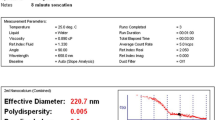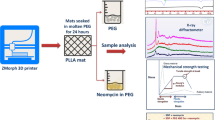Abstract
Biomimetic material coatings and negative pressure wound therapy (NPWT) have been shown independently to limit the epithelial downgrowth rates in percutaneous devices. It was therefore hypothesized that these techniques, in combination, could further limit the clinically observed epithelial downgrowth around these devices. In this study, we evaluated the efficacy of two biomimetic coatings, collagen and hydroxyapatite (HA), to prevent downgrowth when used with continuous NPWT. Using an established single-stage surgical protocol, collagen (n = 10) and HA (n = 10) coated devices were implanted subdermally on the back of hairless guinea pigs. Five animals from each group were subjected to continuous ~90 mmHg NPWT. Four weeks post-implantation, animals were sacrificed, and the devices and surrounding tissues were harvested, processed, and downgrowth was computed and compared to historical porous titanium coated controls. Data showed a significant reduction in downgrowth in NPWT treated animals (p ≤ 0.05) when compared to the untreated porous titanium controls. HA coated devices, without the NPWT treatment, also showed significantly decreased downgrowth compared to the untreated porous titanium controls.






Similar content being viewed by others
References
Tillander J, Hagberg K, Hagberg L, Branemark R. Osseointegrated titanium implants for limb prostheses attachments: infectious complications. Clin Orthop Relat Res. 2010;468:2781–8.
Sullivan J, Uden M, Robinson KP, Sooriakumaran S. Rehabilitation of the trans-femoral amputee with an osseointegrated prosthesis: the United Kingdom experience. Prosthet Orthot Int. 2003;27:114–20.
Van de Meent H, Hopman MT, Frolke JP. Walking ability and quality of life in subjects with transfemoral amputation: a comparison of osseointegration with socket prostheses. Arch Phys Med Rehabil. 2013;94:2174–8.
Hagberg K, Branemark R. One hundred patients treated with osseointegrated transfemoral amputation prostheses—rehabilitation perspective. J Rehabil Res Dev. 2009;46:331–44.
Dasse KA. Infection of percutaneous devices: prevention, monitoring, and treatment. J Biomed Mater Res. 1984;18:403–11.
Feldman DS, von Recum AF. Non-epidermally induced failure modes of percutaneous devices. Biomaterials. 1985;6:352–6.
Juhnke DL, Beck JP, Jeyapalina S, Aschoff HH. Fifteen years of experience with integral-leg-prosthesis: cohort study of artificial limb attachment system. J Rehabil Res Dev. 2015;52:407–20.
von Recum AF. Applications and failure modes of percutaneous devices: a review. J Biomed Mater Res. 1984;18:323–36.
Black J. Biological performance of materials: fundamentals of biocompatibility. 4th ed. Boca Raton: CRC Taylor & Francis; 2006.
Zhao L, Chu PK, Zhang Y, Wu Z. Antibacterial coatings on titanium implants. J Biomed Mater Res B Appl Biomater. 2009;91:470–80.
Holt BM, Bachus KN, Beck JP, Bloebaum RD, Jeyapalina S. Immediate post-implantation skin immobilization decreases skin regression around percutaneous osseointegrated prosthetic implant systems. J Biomed Mater Res A. 2013;101:2075–82.
Gristina AG, Naylor P, Myrvik Q. Infections from biomaterials and implants: a race for the surface. Med Prog Technol. 1988;14:205–24.
Anderson JM, Rodriguez A, Chang DT. Foreign body reaction to biomaterials. Semin Immunol. 2008;20:86–100.
Chehroudi B, Gould TR, Brunette DM. The role of connective tissue in inhibiting epithelial downgrowth on titanium-coated percutaneous implants. J Biomed Mater Res. 1992;26:493–515.
Aschoff HH, Kennon RE, Keggi JM, Rubin LE. Transcutaneous, distal femoral, intramedullary attachment for above-the-knee prostheses: an endo-exo device. The Journal of bone and joint surgery. J Bone Joint Surg Am. 2010;92:180–6.
Branemark R, Berlin O, Hagberg K, Bergh P, Gunterberg B, Rydevik B. A novel osseointegrated percutaneous prosthetic system for the treatment of patients with transfemoral amputation: a prospective study of 51 patients. Bone Joint J. 2014;96-B:106–13.
Trindade R, Albrektsson T, Tengvall P, Wennerberg A. Foreign body reaction to biomaterials: on mechanisms for buildup and breakdown of osseointegration. Clin Implant Dent Relat Res. 2016;18:192–203.
Rimondini L, Fare S, Brambilla E, Felloni A, Consonni C, Brossa F et al. The effect of surface roughness on early in vivo plaque colonization on titanium. J Periodontol. 1997;68:556–62.
Squier CA, Collins P. The Relationship between soft-tissue attachment, epithelial downgrowth and surface porosity. J Periodontal Res. 1981;16:434–40.
Kim H, Murakami H, Chehroudi B, Textor M, Brunette DM. Effects of surface topography on the connective tissue attachment to subcutaneous implants. Int J Oral Maxillofac Implants. 2006;21:354–65.
Anderson JM. Biological responses to materials. Annu Rev Mater Res. 2001;31:81–110.
Isackson D, McGill LD, Bachus KN. Percutaneous implants with porous titanium dermal barriers: an in vivo evaluation of infection risk. Med Eng Phys. 2011;33:418–26.
Mitchell SJ, Jeyapalina S, Nichols FR, Agarwal J, Bachus KN. Negative pressure wound therapy limits downgrowth in percutaneous devices. Wound Repair Regen. 2015;24:35–44.
Jeyapalina S, Beck JP, Bachus KN, Williams DL, Bloebaum RD. Efficacy of a porous-structured titanium subdermal barrier for preventing infection in percutaneous osseointegrated prostheses. J Orthop Res. 2012;30:1304–11.
Ratner BD. Reducing capsular thickness and enhancing angiogenesis around implant drug release systems. J Control Release. 2002;78:211–8.
Chehroudi B, Gould TRL, Brunette DM. Titanium-coated micromachined grooves of different dimensions affect epithelial and connective-tissue cells differently in vivo. J Biomed Mater Res. 1990;24:1203–19.
Pendegrass CJ, Goodship AE, Blunn GW. Development of a soft tissue seal around bone-anchored transcutaneous amputation prostheses. Biomaterials. 2006;27:4183–91.
Kang NV, Morritt D, Pendegrass C, Blunn G. Use of ITAP implants for prosthetic reconstruction of extra-oral craniofacial defects. J Plast Reconstr Aesthet Surg. 2013;66:497–505.
Kang NV, Pendegrass C, Marks L, Blunn G. Osseocutaneous integration of an intraosseous transcutaneous amputation prosthesis implant used for reconstruction of a transhumeral amputee: Case report. J Hand Surg Am. 2010;35:1130–4.
Lancerotto L, Bayer LR, Orgill DP. Mechanisms of action of microdeformational wound therapy. Semin Cell Dev Biol. 2012;23:987–92.
Erba P, Ogawa R, Ackermann M, Adini A, Miele LF, Dastouri P, et al. Angiogenesis in wounds treated by microdeformational wound therapy. Ann Surg. 2011;253:402–9.
Orgill DP, Bayer LR. Update on negative-pressure wound therapy. Plast Reconst Surg. 2011;127:105S–15S.
Orgill DP, Bayer LR. Negative pressure wound therapy: past, present and future. Int Wound J. 2013;10:15–9.
Holt BM, Betz DH, Ford TA, Beck JP, Bloebaum RD, Jeyapalina S. Pig dorsum model for examining impaired wound healing at the skin-implant interface of percutaneous devices. J Mater Sci Mater Med. 2013;24:2181–93.
Turksen K. Epidermal cells: methods and protocols. New York, NY: Humana Press; 2010.
Morasso MI, Tomic-Canic M. Epidermal stem cells: the cradle of epidermal determination, differentiation and wound healing. Biol Cell. 2005;97:173–83.
Geissler U, Hempel U, Wolf C, Scharnweber D, Worch H, Wenzel K. Collagen type I-coating of Ti6Al4V promotes adhesion of osteoblasts. J Biomed Mater Res. 2000;51:752–60.
Bellis SL. Advantages of RGD peptides for directing cell association with biomaterials. Biomaterials. 2011;32:4205–10.
Flanagan M (eds). Wound healing and skin integrity: principles and practice. Chichester, UK: John Wiley & Sons Ltd. 2013; 3rd edition.
Buckley CD, Pilling D, Henriquez NV, Parsonage G, Threlfall K, Scheel-Toellner D et al. RGD peptides induce apoptosis by direct caspase-3 activation. Nature. 1999;397:534–9.
Cook SJ, Nichols FR, Jeyapalina S, Bachus KN. Two-stage surgical approach limits skin downgrowth around a percutaneous device. New Orleans, LA: Transactions of the Annual Meeting of the Orthopaedic Research Society; 2014.
Emmanual J, Hornbeck C, Bloebaum RD. A polymethyl methacrylate method for large specimens of mineralized bone with implants. Stain Technol. 1987;62:401–10.
Pendegrass CJ, Gordon D, Middleton CA, Sun SN, Blunn GW. Sealing the skin barrier around transcutaneous implants: in vitro study of keratinocyte proliferation and adhesion in response to surface modifications of titanium alloy. J Bone Joint Surg Br. 2008;90:114–21.
Holt B, Tripathi A, Morgan J. Viscoelastic response of human skin to low magnitude physiologically relevant shear. J Biomech. 2008;41:2689–95.
Ducheyne P, Healy K, Hutmacher DW, Grainger DW, Kirkpatrick CJ. Comprehensive biomaterials, (eds Ducheyne) 1st ed. Elsevier Science, 2011.
Pendegrass CJ, Goodship AE, Price JS, Blunn GW. Nature’s answer to breaching the skin barrier: an innovative development for amputees. J Anat. 2006;209:59–67.
Jansen JA, van der Waerden JP, de Groot K. Tissue reaction to bone-anchored percutaneous implants in rabbits. J Investig Surg. 1992;5:35–44.
Wu Y, Yang BC, Deng CL, Tan YF, Zhang XD. The influence of surface bioactivated modification on titanium percutaneous implants anchored in bone. Int J Artif Organs. 2006;29:630–8.
Oyane A, Hyodo K, Uchida M, Sogo Y, Ito A. Preliminary in vivo study of apatite and laminin-apatite composite layers on polymeric percutaneous implants. J Biomed Mater Res B Appl Biomater. 2011;97:96–104.
Smith TJ, Galm A, Chatterjee S, Wells R, Pedersen S, Parizi AM et al. Modulation of the soft tissue reactions to percutaneous orthopaedic implants. J Orthop Res. 2006;24:1377–83.
Fitzpatrick N, Smith TJ, Pendegrass CJ, Yeadon R, Ring M, Goodship AE et al. Intraosseous transcutaneous amputation prosthesis (ITAP) for limb salvage in 4 dogs. Vet Surg. 2011;40:909–25.
Bloebaum RD, Beeks D, Dorr LD, Savory CG, DuPont JA, Hofmann AA. Complications with hydroxyapatite particulate separation in total hip arthroplasty. Clin Orthop Relat Res. 1994;298:19–26.
Acknowledgements
This work was supported in part by the Department of Defense [#W81XWH-11-1-0435, 2010], by the United States Department of Veterans Affairs Rehabilitation Research and Development Service under Merit Review Award [#I01RX001217, 2014], and by the Department of Orthopaedics, University of Utah School of Medicine, Salt Lake City, Utah. The views, opinions, and/or findings presented are those of the authors and should not be construed as an official position, policy or decision of any of these funding sources unless so designated by other documentation. In conducting research using animals, the investigators adhered to the Animal Welfare Act Regulations and other Federal statutes relating to animals and experiments involving animals and the principles set forth in the current version of the Guide for Care and Use of Laboratory Animals, National Research Council. The authors wish to express their sincere gratitude to Thortex Inc. (Portland, OR) for device fabrication and coating support. They also wish to acknowledge the Bone and Joint Research Laboratory’s Histology Team for their technical expertize with the samples embedment process, and Greg Stoddard for his help with statistical analysis.
Author information
Authors and Affiliations
Corresponding authors
Ethics declarations
Conflict of interest
The authors declare that they have no conflict of interest.
Additional information
Publisher’s note: Springer Nature remains neutral with regard to jurisdictional claims in published maps and institutional affiliations.
Rights and permissions
About this article
Cite this article
Jeyapalina, S., Mitchell, S.J., Agarwal, J. et al. Biomimetic coatings and negative pressure wound therapy independently limit epithelial downgrowth around percutaneous devices. J Mater Sci: Mater Med 30, 71 (2019). https://doi.org/10.1007/s10856-019-6272-4
Received:
Accepted:
Published:
DOI: https://doi.org/10.1007/s10856-019-6272-4




